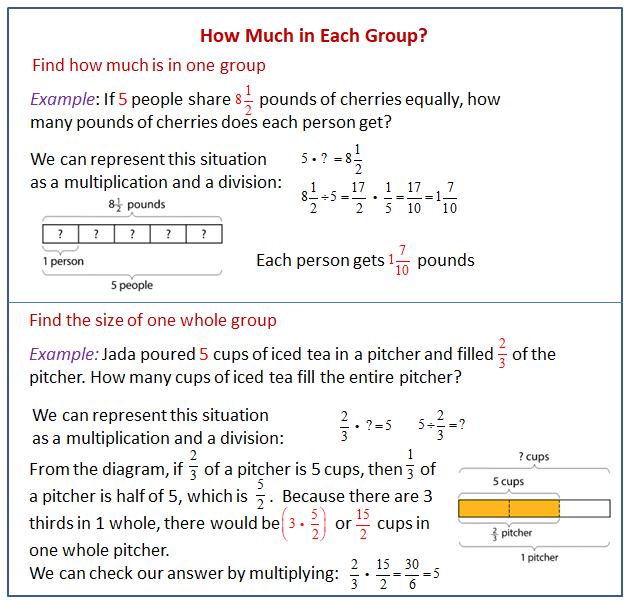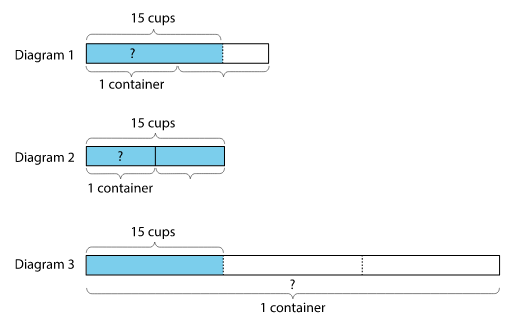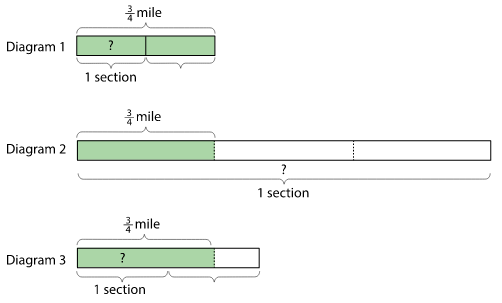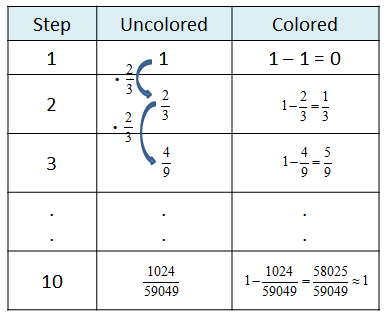Illustrative Mathematics Unit 6.4, Lesson 8: How Much in Each Group? (Part 1)
Learning Targets:
- I can tell when a question is asking for the amount in one group.
- I can use diagrams and multiplication and division equations to represent and answer “how much in each group?” questions.
Related Pages
Illustrative Math
Grade 6
Lesson 8: What Fraction of a Group?
Let’s look at division problems that help us find the size of one group.
Illustrative Math Unit 6.4, Lesson 8 (printable worksheets)
Lesson 8 Summary
The following example shows how to use diagrams and multiplication and division equations to find the size of one group.

Lesson 8.1 Inventing a Scenario
- Think of a situation with a question that can be represented by 12 ÷ ⅔ = ? Write a description of that situation and the question.
- Trade descriptions with your partner, and answer your partner’s question.
Scroll down the page for the answers to the “Are you ready for more section?”
Lesson 8.2 How Much in One Batch?
To make 5 batches of cookies, 10 cups of flour are required. How many cups of flour does each batch require?
We can write equations and draw a diagram to represent this situation. They help us see that each batch requires 2 cups of flour.
- To make 4 batches of cupcakes, it takes 6 cups of flour. How many cups of flour are needed for 1 batch?
- To make ½ batch of rolls, it takes 5/4 cups of flour. How many cups of flour are needed for 1 batch?
- Two cups of flour make ⅔ batch of bread. How many cups of flour make 1 batch?
Lesson 8.3 One Container and One Section of Highway
Here are three tape diagrams and three descriptions of situations that include questions.
Match a diagram to each situation, then use the diagram to help you answer the question. Next, write multiplication and division equations to represent each situation.
- Tyler poured 15 cups of water into 2 equal-sized bottles and filled each bottle. How much water was in each bottle?
Diagram:
Answer:
Multiplication equation:
Division equation: - Kiran poured 15 cups of water into equal-sized pitchers and filled 1½ pitchers. How much water was in the full pitcher?
Diagram:
Answer:
Multiplication equation:
Division equation: - It takes 15 cups of water to fill ⅓ pail. How much water is needed to fill 1 pail?
Diagram:
Multiplication equation:
Division equation:
Here are three more diagrams and situations. Match a diagram to each situation, and use the diagram to help you answer the question. Next, write multiplication and division equations to represent each situation. - Priya’s class has adopted two equal sections of a highway to keep clean. The combined length is ¾ of a mile. How long is each section?
Diagram:
Answer:
Multiplication equation:
Division equation: - Lin’s class has also adopted some sections of highway to keep clean. If 1½ sections are ¾ mile long, how long is each section?
Diagram:
Answer:
Multiplication equation:
Division equation: - A school has adopted a section of highway to keep clean. If of the section is mile long, how long is the section?
Diagram:
Answer:
Multiplication equation:
Division equation:
Are you ready for more?
To make a Cantor ternary set:
- Start with a tape diagram of length 1 unit. This is step 1.
- Color in the middle third of the tape diagram. This is step 2.
- Do the same to each remaining segment that is not colored in. This is step 3.
- Keep repeating this process.
- How much of the diagram is colored in after step 2? Step 3? Step 10?
- If you continue this process, how much of the tape diagram will you color?
- Can you construct a process that will give you a similar kind of object? For example, color the first fifth instead of the middle third of each strip.
Lesson 8 Practice Problems
- For each scenario, use the given tape diagram to help you answer the question. Mark up and label the diagrams as needed.
a. Mai has picked 1 cup of strawberries for a cake, which is enough for ¾ of the cake. How many cups does she need for the whole cake? b. Priya has picked 1½ cups of raspberries, which is enough for ¾ of a cake. How many cups does she need for the whole cake? - Tyler painted 9/2 square yards of wall area with 3 gallons of paint. How many gallons of paint does it take to paint each square yard of wall?
a. Write multiplication and division equations to represent the situation.
b. Draw a diagram to represent the situation and to answer the question. - After walking ¼ mile from home, Han is ⅓ of his way to school. What is the distance between his home and school?
a. Write multiplication and division equations to represent this situation.
b. Use the given diagram to help you answer the question. Mark up and label it as needed. - Here is a division equation: ⅘ ÷ ⅔ =
a. Write a multiplication equation that corresponds to the division equation.
b. Draw a diagram to represent and answer the question. - A set of books that are each 1.5 inches wide are being organized on a bookshelf that is 36 inches wide. How many books can fit on the shelf?
a. Write a multiplication equation and a division equation to represent this question.
b. Find the answer. Draw a diagram, if needed.
c. Use the multiplication equation to check your answer. - a. Without calculating, order the expressions based on their values, from smallest to largest.
56 ÷ 8
56 ÷ 8,000,000
56 ÷ 0.000008
Explain how you decided the order of the three expressions.
Find a number n so that n is greater than 1 but less than 7.
The Open Up Resources math curriculum is free to download from the Open Up Resources website and is also available from Illustrative Mathematics.
Try the free Mathway calculator and
problem solver below to practice various math topics. Try the given examples, or type in your own
problem and check your answer with the step-by-step explanations.

We welcome your feedback, comments and questions about this site or page. Please submit your feedback or enquiries via our Feedback page.





